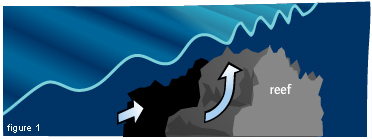The Canoe Is the People
Indigenous Navigation in the Pacific
Sea Marks

A wayfinder also relies on sea marks located in specific places to find the way. It might not be best to take the shortest path to an island if this means that you cannot check your course by seeing or feeling the sea marks. Wayfinders learn to use sea marks through experience as well as through stories and songs about them.
Reefs GLOSSARY reefs - areas of rock or coral below the surface of the water may act as sea marks, even those up to 50 m below the surface. The water above a reef has a different colour (light green) from the sea around it (blue). Short, steep waves sometimes form above a reef too. They are caused by a current GLOSSARY current - the directional flow of the sea meeting the reef. If the sea is flat, a navigator can see these waves from some kilometres away. At night, a wayfinder can feel the canoe move differently over them [See figure 1].
Sea life (like sharks, whales, and dolphins) also act as sea marks for a navigator. Extraordinary animals are often found at the same place along a path, even over centuries. Some are well known to navigators and have been given their own names. They can be as helpful as reefs in guiding the navigator. Some sea life can also be guides to show you where to find the land.
Knowledge about sea marks is closely protected. Student navigators chant GLOSSARY chant - sing, say lists of marks that they can look for between an island and each star point. A wayfinder’s family member may sing or tell a story about these sea marks while the wayfinder is at sea.
The song of Tutu ne Naipa (Shower of Naipa)
Satawalese Lourdes Lepanemai sings the song of Tutu ne Naipa (Shower of Naipa), which names a lot of sea life. The lady called Naipa goes to shower in Powrow on the reef. A wind comes down to her from the south. The men are shouting that a vaka is coming. It is Gamomumonu, who is getting away from his father. He is sailing to the south, under the stars. He sees the shark in its place. The leaf of the nat tree floats out from the beach. Now you are going to drink your nuu (coconut). The asaf (frigate bird) called Tinimwar – one of his hands in the west by Eurpiik and his neck and head by Metau Sarik (the ocean path between Satawal and Pik)… You are going to Pik to get the suum (giant clam) on the reef… for Naosow because she is thirsty and hungry.






